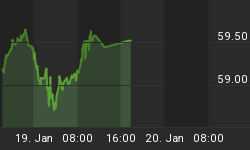Dow Jones Industrial Average 10,302
Value Line Arithmetic Index 1,811
30-Year Treasury Index 4.30%
The Big Picture for Stocks
The 4-year cycle is negative into 2006.
Technical Trendicator (1-4 month trend):
Stock Prices Down
Bond Prices Down
An historical emphasis by the Fed has been to control inflation. A couple of years ago, the Fed appeared to be worried about the possibility of a Japanese style deflation. Those fears have abated and inflation is once again the focus.
In a world where governments can in effect print money in most situations, inflation will be the predominant problem. That does not eliminate the possibility of deflation. In fact, it seems probable to me that sooner or later we will have a bout with deflation. We have had so much debt expansion relative to our ability to pay off that debt (see chart from ContraryInvestor.com), at some point the cycle will change and the debt will have to contract. That in turn will create a situation that economists call "pushing on a string." All attempts to stimulate the economy will fail because people will not (cannot) borrow any more, and deflation will result.
But for now, inflation is the concern of the Fed. Al Greenspan will not want to leave as his legacy an inflationary spiral. For this reason he is even more than normally concerned about the rising inflation situation. He will keep pushing on the breaks until the Fed sees results on this front.
Short term interest rates have been increasing for two years. Are we experiencing tight money? Not yet, at least. Note that the fed funds rate is about 3.25. The year-over-year CPI is about 3. So the spread is only about 25 basis points. The historical spread is 150 to 200 basis points. So on that basis, we really have an easy money policy by the Fed, not tight money. It would seem reasonable to expect that the Fed will eventually reach the normal spread over the CPI if they really want to control inflation. So interest rates are probably going higher.
Over time there has almost always been inflation, at least since the founding of Federal Reserve Board. But where inflation finds its focus tends to rotate. In the early 1980's it was the price of money (interest rates). In the late 1990's it was technology stocks. Today, important commodities like copper and oil are at record highs and climbing. Also, look at home prices. The rate of increase in home prices nationally has been steadily growing from 2.6% in 1996 to 12.5% in 2005. What has lagged lately is the Consumer Price Index, the most visible measure of inflation (http://www.bls.gov/cpi/home.htm).
What if the focus of inflation hones in on the price of goods that make up the CPI while home prices and industrial commodity prices cool off? That would be an interesting situation for the Fed. They might worry that a slide in housing prices would hurt consumer spending, and begin to ease. On the other hand, since the CPI is so visible, they might have to tighten further. If the CPI moves on up, let's say to 5% or higher, one could envision the Fed moving short rates to 7%.
Another possible outlet for the inflationary trends in the economy is gold. Gold really has not gone up that much, especially versus stock prices. We have shown the chart below before. It shows the price of gold versus the S&P 500. There is a cycle here that favors gold.
So what does all this mean to investors? Perhaps the best bet on a risk/reward basis is high quality short-term debt instruments - T-Bills. Perhaps even better are general obligation debt instruments of states that have a balanced budget requirement, such as Texas. I think this cash component of one's portfolio should be at least 50%.
The balance should be very diversified and should include some gold and some short sales or bear funds. Especially if I lived on either coast, where the real estate market has been so hot, I would sell my house. And certainly, get out of debt.
I have always liked small and microcap stocks for growth. If you can bear the high risk, take a small part of your portfolio and put it in small companies that have the potential for accelerating sales growth, such as those on our Special Situations list. Today's attack in Britain is a reminder of the terrorist threat and the continued opportunity in homeland defense stocks, in which we are represented on our list.















